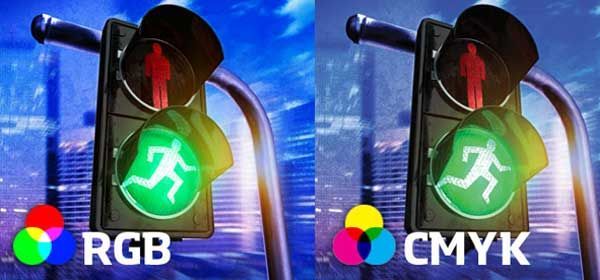The body content of your post goes here. To edit this text, click on it and delete this default text and start typing your own or paste your own from a different source.

When the prepress department receives art for a job, one of the most common oversights we see in any given file is the use of RGB (Red/Green/Blue) color space, when print technology is based on CMYK (Cyan/Magenta/Yellow/BlacK). So what’s the difference? Obviously in the example image here, the RGB version is more vivid, colorful and all-around better looking. So what’s the problem? Can’t that press use RGB?
Well, it’s not really that simple. RGB and CMYK are opposites of each other — additive and subtractive color spaces. In plain English, that simply means that in RGB, if you add all colors in the spectrum together, you get white. This is how the human eye perceives color, and is how computer monitors and TV screens present color. RGB, essentially, is based on light.
CMYK, on the other hand, is necessarily based on ink. As all of the colors are added together, the result is black. If you’ve ever mixed colors in a home painting kit, you may have been disappointed after accidentally producing black paint when you tried to mix too many tones. This is the same concept. While RGB adds more light to create brighter colors, CMYK absorbs (subtracts) light, creating darker tones. The difference between the two color spaces is most apparent in blue and green tones, as shown in the traffic light image.

The issue comes into play because Adobe Photoshop, the most widely used program for graphic design, selects the RGB color space by default when creating a new file. It’s an understandable choice — most design work is created for media that’s viewed on a screen (light-based color) and RGB has a wider range of colors. Most designers don’t give it a second thought, but these are major matters to a printer who then has to attempt to match the vivid colors with a more limited color spectrum. Depending on the image, a great deal of manual adjustment may be needed to return the color to something even resembling the original RGB image… and even that may not be possible. The problem is that even if the printer is able to color-correct the image back into a pleasing range, it can take an inordinate amount of time — which means a greater cost for both customer and printer.
The safest solution is to simply design in CMYK from the beginning. If this is not possible, convert the source images to CMYK before sending to the printer so you can see how much of a difference the conversion will make.
But even this can lead to false results at times. To truly see how a file will really look when printed, it must be previewed with overprinting, an option in Adobe Illustrator that’s available only in CMYK mode.

To preview overprinting, select the “Window” pulldown in Illustrator, and then “Separations Preview” (highlighted). In the window that appears, check the “Overprint Preview” box. This allows colors to be toggled on and off, previewing how each individual print plate will appear. This gives a more accurate impression of how colors will appear when mixed together (especially useful if spot colors are present).
Soon we’ll look at other uses for the Overprint Preview and how it can help detect a range of print issues before they happen.

More Posts



American Carton Company
As an independent, full-service folding carton company, ACC routinely designs and manufactures innovative packaging solutions for a variety of businesses.
607 South Wisteria Street • Mansfield, TX 76063
Copyright ©2024 American Carton Company. All Rights Reserved.
Employee Resources


